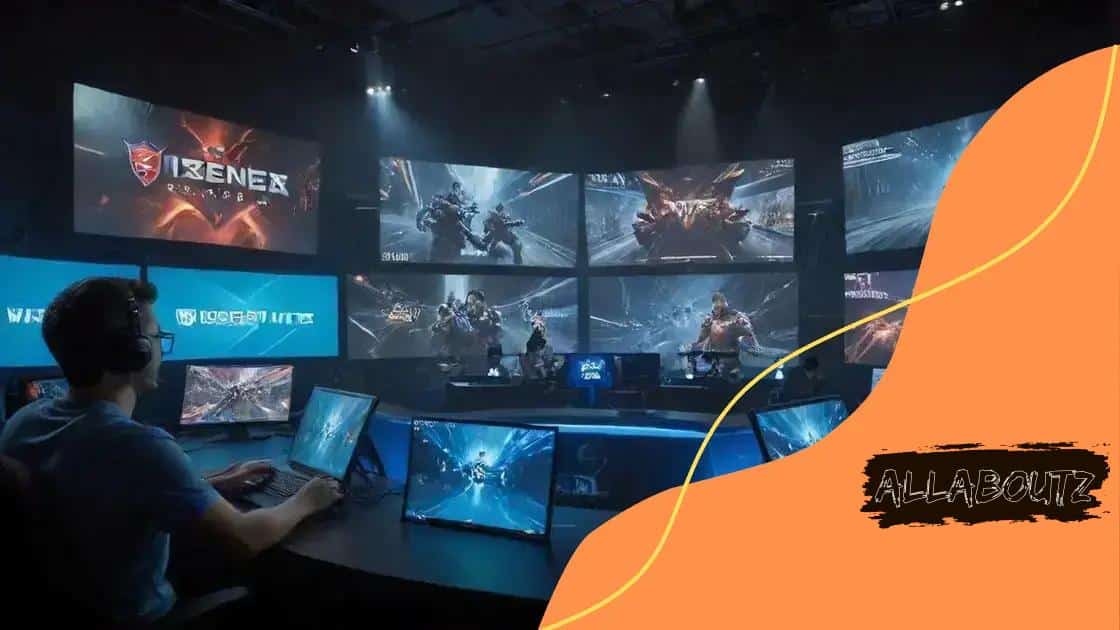How e-sports are influencing mainstream media content

How e-sports are influencing mainstream media content involves the integration of gaming in traditional broadcasts, the rise of diverse audiences, and innovative technologies enhancing viewer engagement.
How e-sports are influencing mainstream media content is a fascinating topic that highlights the intersection of gaming and entertainment. Have you noticed how major networks are now covering gaming tournaments? It’s not just a trend; it’s changing the game.
The rise of e-sports in popular culture
The rise of e-sports in popular culture has been nothing short of a phenomenon. Over the last decade, competitive gaming has moved from niche communities to mainstream audiences. Many people are now tuning in to watch live streams of video game tournaments, filling stadiums and arenas around the world.
Unprecedented Growth
As interest in e-sports grows, so does its impact on society. The inclusion of games like League of Legends and Fortnite in popular events shows how these games are connecting with audiences, much like traditional sports. Viewers are not only watching but also engaging with streamers and professional players.
Some key aspects of the boom include:
- The influx of sponsorships from major brands.
- The development of professional leagues and tournaments.
- Growing viewership on platforms like Twitch and YouTube.
- The increasing acceptance of gaming as a legitimate career path.
Cultural Impact
This shift has allowed e-sports to influence youth culture significantly. Players are often seen as role models. Their skills not only entertain but also inspire others to pursue gaming with greater seriousness. As more people recognize successful players, we see increased legitimacy and respect for gaming.
Moreover, popular culture is embracing gaming in various forms. Movies, music, and even fashion are starting to reflect this shift. Brands are collaborating with e-sports teams, bringing gaming into their marketing strategies. This creates a richer connection between gaming and everyday life, further embedding it in the cultural zeitgeist.
Furthermore, educational institutions are considering e-sports as part of their curricula, offering scholarships for gameplay, which showcases the growing recognition of e-sports as a serious discipline. What’s next for this budding industry? More media coverage and perhaps a foothold in the Olympics are on the horizon, indicating the momentum is just beginning.
Key partnerships between media and e-sports
Key partnerships between media and e-sports have transformed the landscape of entertainment. As e-sports gain prominence, major media outlets are eager to be part of the action. This collaboration is beneficial for both parties, creating new opportunities and engaging a wider audience.
Significant Collaborations
Many media companies are forming partnerships with e-sports organizations. These alliances result in increased visibility for gaming events. Traditional sports networks, like ESPN, are airing e-sports tournaments. This helps to legitimize gaming in the eyes of the mainstream audience.
Crucial partnerships include:
- Media companies broadcasting tournaments on television.
- Streaming platforms like Twitch collaborating with gaming leagues.
- Brands sponsoring events for marketing exposure.
- Game developers working with media for promotional content.
Impact on Audience Engagement
With these partnerships, engagement with the gaming community has skyrocketed. Fans can easily watch games and interact with players live. This is a significant shift from traditional broadcasting. The excitement of e-sports resonates well with the younger demographic.
Moreover, these collaborations lead to innovative content creation. Media outlets are now producing original shows centered on gaming. This kind of content attracts viewers who may not have been interested before, broadening the reach of e-sports.
As both industries evolve together, the potential for future collaborations is enormous. Brands are recognizing the value of associating with the gaming community. Such partnerships can enhance audience loyalty and create thriving ecosystems for e-sports events.
Impact on traditional sports broadcasting

The impact on traditional sports broadcasting from the rise of e-sports is profound. Traditional sports networks are now competing with gaming channels for viewers. This shift is changing how audiences consume sports content. Many people are transitioning from watching conventional sports to engaging with e-sports events.
Changing Viewership Trends
As e-sports gain popularity, traditional sports broadcasters have noticed a decline in their audience numbers. Younger viewers, in particular, prefer the excitement and interactivity of gaming. This trend is forcing networks to rethink their strategies and look for ways to attract these new viewers.
Key changes in broadcasting include:
- Incorporating gaming content into regular sports programming.
- Utilizing digital platforms for streaming competitions.
- Collaborating with e-sports organizations for exclusive content.
- Offering interactive features like live chats during broadcasts.
Adapting to the New Landscape
To stay relevant, traditional broadcasters are investing in e-sports coverage. They are not just airing events but also aiming to create engaging programming around them. This can include interviews with professional players, analysis of gameplay, and behind-the-scenes coverage. These elements draw in fans who want to learn more about their favorite games and players.
Additionally, some networks are experimenting with new formats. These include reality shows centered around e-sports, which appeal to a broader audience. By adapting to the changes in viewer preferences, traditional broadcasting is finding new life in this competitive landscape.
As the line between traditional sports and e-sports continues to blur, it is clear that the future of broadcasting will include a diverse array of content to cater to all fans.
Audience demographic shifts due to e-sports
Audience demographic shifts due to e-sports have transformed the landscape of gaming and entertainment. The demographic of gamers has evolved significantly, attracting a diverse group of viewers from various backgrounds. This shift has implications not only for the gaming industry but also for advertisers and content creators.
Who is Watching?
The typical e-sports fan is no longer solely a young male. Today, many viewers are increasingly diverse. More women and older adults are watching e-sports, leading to a broader appeal. This demographic change means new opportunities for brands to connect with a wider audience.
Key demographic trends include:
- A rise in female e-sports viewers, with events catering specifically to them.
- Older fans, especially in age groups 25-34 and 35-44, engaging with competitive gaming.
- Increased interest from parents who support their children’s gaming endeavors.
- Global viewership with audiences from various countries tuning in.
Changing Engagement Patterns
With these shifts, engagement patterns have also changed. Fans are not just passive viewers; they actively participate in online communities related to e-sports. Many engage through social media, Twitch streams, and forums, creating vibrant discussions about their favorite games and players.
This active involvement leads to different ways brands connect with audiences. Marketing strategies are adapting to focus more on interactive experiences, like live streams and social media campaigns, than traditional advertising. Brands see the potential in engaging audiences through these platforms to boost loyalty and brand awareness.
Overall, the evolution of audience demographics in e-sports indicates a thriving and dynamic community. This growing diversity will likely shape the future of gaming and the way content is created, consumed, and marketed.
Future trends in media coverage of e-sports
Future trends in media coverage of e-sports are poised to reshape how audiences engage with competitive gaming. As technology evolves and viewer preferences change, media outlets are adapting their strategies. The integration of innovative technologies will be key in enhancing the viewing experience.
Increased Use of Augmented Reality
One of the most exciting developments is the potential use of augmented reality (AR) in e-sports broadcasts. AR can provide viewers with immersive experiences. For instance, viewers could see real-time game statistics and player analytics overlaid on their screens. This technology could turn watching a game into an interactive experience.
Expect to see:
- Enhanced graphics and animations during live games.
- Interactive player profiles that update in real-time.
- Special features like virtual commentary to engage audiences further.
Expansion into Mainstream Broadcasts
Another trend is the increasing presence of e-sports in mainstream sports broadcasts. Major sports networks are expanding their programs to include e-sports events. This strategy not only attracts younger viewers but also provides traditional audiences with insight into this rapidly growing field.
Collaboration between e-sports leagues and traditional media can foster partnerships leading to new programming. For instance, networks may feature special episodes focusing on game strategies or player backgrounds. This approach will make e-sports more relatable to general sports fans.
As networks invest in quality production and storytelling, the coverage of e-sports will become more engaging. Personalized content will cater to diverse interests. This results in a community that feels connected and invested in the games and players.
Overall, future trends are set to transform how e-sports are covered, providing an exciting landscape for fans and stakeholders alike. The combination of technology and media innovation promises to take the e-sports viewing experience to new heights.
FAQ – Frequently Asked Questions about E-Sports and Media Coverage
How are e-sports influencing traditional media?
E-sports are gaining popularity, prompting traditional media to incorporate gaming coverage, thus attracting younger audiences and adapting their content.
What technological trends are emerging in e-sports broadcasting?
Augmented reality and interactive features are set to enhance viewer experiences, allowing real-time statistics and immersive engagement.
Who is the typical audience for e-sports events?
The audience for e-sports is increasingly diverse, including more women and older adults, rather than just young males.
What opportunities do future trends in e-sports present?
Future trends open up exciting possibilities for brands to connect with a wider audience through interactive content and mainstream collaborations.





